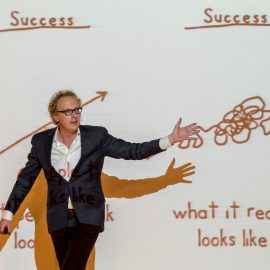 It’s a challenge each of us has to face every once in a while: giving a presentation. As you can probably imagine I’ve come across my fair share of public speakers at various events. Some of these presentations are quite good, but most need a lot of work. So, let me do my part and give you a few pointers before taking the stage.
It’s a challenge each of us has to face every once in a while: giving a presentation. As you can probably imagine I’ve come across my fair share of public speakers at various events. Some of these presentations are quite good, but most need a lot of work. So, let me do my part and give you a few pointers before taking the stage.
The opening is crucial. Like it or not, your audience will decide whether they like you or not within the first minutes of your presentation. If you fail to make a good impression, you lose. Make sure about 30% of your preparation time is spent on your opening. Of course, there are several options:
- Start with the second-best personal experience you can think of – you want to keep the very best for last.
- Have the audience respond to an opening statement or question by raising their hands. Don’t forget to actually respond to it!
- Start with a striking observation, something you’ve learned during the break, or something you noticed while listening to other speakers (beware, this is higher level stuff!).
Take your audience with you on a well-structured journey. Present your listeners with a broad overview of what you’re about to do. Tell them what argument you want to make, highlight the building blocks of your story and gently tickle them with a good story or anecdote. “In a little while, you will know what we did to raise our NPS scores and how a pink elephant was crucial to this success.” Why do this? It triggers people – they will keep listening to figure out what happened to the pink elephant!
The power of examples. Let’s face it: most presentations are terribly boring. Why? Because they lack personality and are devoid of any vulnerabilities. They are often fantastical tales, filled with Barbies, unicorns and rainbows, in which nothing ever goes wrong. Such a waste! You can’t have ups without the downs, so start digging. Where are your organization’s best stories? Where did it, initially, go wrong? What did you change? When did things start looking up again?
Kill your PowerPoint. The inexperienced among us often use PowerPoint as a cheat-sheet. As a result, everything you want to say has to be on the slide. PowerPoint should support what you’re saying, so don’t make it a transcript. My top tip? First create your presentation and practice it without visuals before making your PowerPoint. When you do get around to creating something beautiful, limit yourself to a maximum of 4 words per slide and use a lot of pictures! Also, Prezi isn’t your friend either if your presentation is badly written to start with.
Body language and voice. Not unlike other things in life, presentations, too, abide by the fake it until you make it adage. In no way, shape or form do professional presentations benefit from confessions of nervousness, sickness or other personal tragedies. You’re either present or you aren’t. And when you’re present, you’re going to conquer that audience. This I’ll show them what I am made of mindset translates into confident body language and better use of your voice. So what if you make a mistake, or if the technology decides to call it quits right in the middle of your presentation? Don’t let it get to you and keep at it! Don’t get distracted or, if you feel up to it, make a joke about it. In fact, that may be the best advice I can give you and it applies to every presentation: try and have fun.
Get a move on. One of the most frequent mistakes is a slow start. Starting too slow means you’ll never get to the heart of your message in time. If you feel like you’ve been talking for 10 minutes, it’s more likely you’ve been at it for 20 minutes already. I can’t tell you how many speakers strand in the beginning. Open strong and waste no time: cut to the chase already!
The 3 Ps. People that give great presentations seem to do so without effort. I’ll let you in on a little secret: this is not even remotely true. Every great presentation is the product of hard labor, of polishing and then polishing some more. Why do you think even big-name comedians try out their new material in small comedy cellars? It’s about practicing the entire presentation out loud – no shortcuts! That brings me to the 3 Ps: practice, practice and, you’ve guessed it, practice. Don’t read through your presentation, speak it! It’s the only way to find out where you lose track, which parts are going really well, and a great new joke might just pop into your head.



